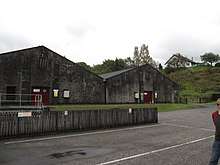Capnodiales
| Capnodiales | |
|---|---|
 | |
| Baudoinia compniacensis growing on Blair Athol distillery, feeding on the angel's share | |
| Scientific classification | |
| Kingdom: | Fungi |
| Division: | Ascomycota |
| Subdivision: | Pezizomycotina |
| Class: | Dothideomycetes |
| Subclass: | Dothideomycetidae |
| Order: | Capnodiales Woron. (1925) |
| Families | |
Capnodiales is a diverse order of Dothideomycetes, initially based on the family Capnodiaceae, also known as sooty mold fungi. Sooty molds grow as epiphytes, forming masses of black cells on plant leaves and are often associated with the honeydew secreted by insects feeding on plant sap. This diverse order has been expanded by the addition of several families formerly thought unrelated and now also includes saprobes, endophytes, plant pathogens, lichens and rock-inhabiting fungi. The new additions include the genus Mycosphaerella containing the causal agents of several economically important crop and tree diseases. A small number of these fungi are also able to parasitise humans and animals, including species able to colonise human hair shafts (Piedraia hortae).[2]
References
- ↑ Hughes, S.J. 1972. New Zealand Fungi 17. Pleomorphism in Euantaennariaceae and Metacapnodiaceae, two families of sooty moulds. New Zealand Journal of Botany. 10:225-242
- ↑ Crous PW, Schoch CL, Hyde KD, Wood AR, Gueidan C, De Hoog GS, Groenewald JZ (2009). "Phylogenetic lineages in the Capnodiales". Studies in Mycology. 64: 17–47. doi:10.3114/sim.2009.64.02. PMC 2816965. PMID 20169022.